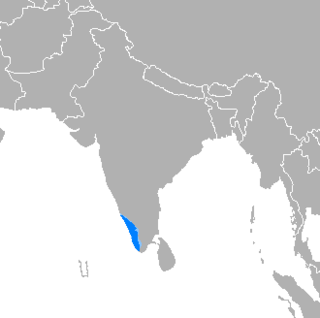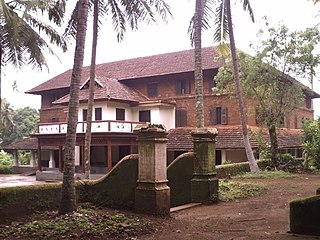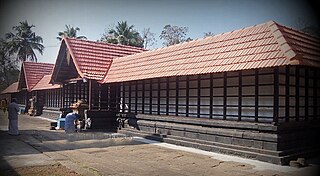
Malayalam is a Dravidian language spoken in the Indian state of Kerala and the union territories of Lakshadweep and Puducherry by the Malayali people. It is one of 22 scheduled languages of India. Malayalam was designated a "Classical Language of India" in 2013. Malayalam has official language status in Kerala, Lakshadweep and Puducherry (Mahé), and is also the primary spoken language of Lakshadweep and is spoken by 35 million people in India. Malayalam is also spoken by linguistic minorities in the neighbouring states; with a significant number of speakers in the Kodagu and Dakshina Kannada districts of Karnataka, and Kanyakumari, Coimbatore and Nilgiris district of Tamil Nadu. It is also spoken by the Malayali Diaspora worldwide, especially in the Persian Gulf countries, due to the large populations of Malayali expatriates there. They are a significant population in each city in India including Mumbai, Bengaluru, Chennai, Delhi, Kolkata, Pune etc. Malayalam is closely related to the Tamil language.

Illam, also referred to as Mana, is the Malayalam word for the house of a Namboodiri Brahmin. In the traditional lineage system used for the classification and identification of homes based on the castes of Kerala, South India, an Illam served as the Tharavad of Nambudiri Brahmin families.

Kolattunādu (Kola Swarupam, as Kingdom of Cannanore in foreign accounts, Chirakkal (Chericul) in later times) was one of the four most powerful kingdoms on the Malabar Coast during the arrival of the Portuguese Armadas in India, along with Zamorin, the Kingdom of Cochin and Quilon. Kolattunādu had its capital at Ezhimala and was ruled by the Kolattiri royal family and roughly comprised the North Malabar region of Kerala state in India. Traditionally, Kolattunādu is described as the land lying between the Chandragiri river in the north and the Korappuzha river in the south. The Kolathunadu (Kannur) Kingdom at the peak of its power, reportedly extended from the Netravati River (Mangalore) in the north to Korapuzha (Kozhikode) in the south with the Arabian Sea on the west and Kodagu hills on the eastern boundary, also including the isolated islands of Lakshadweep in the Arabian Sea.
Melpathur Narayana Bhattathiri Mēlpattūr Nārāyaṇa Bhaṭṭatiri; 1560–1646/1666), third student of Achyuta Pisharati, was a member of Madhava of Sangamagrama's Kerala school of astronomy and mathematics. He was a mathematical linguist (vyakarana). His most important scholarly work, Prakriya-sarvasvam, sets forth an axiomatic system elaborating on the classical system of Panini. However, he is most famous for his masterpiece, Narayaneeyam, a devotional composition in praise of Guruvayurappan (Krishna) that is still sung at Guruvayur Temple.
Azhvanchery Thamprakkal or Azhvanchery Samrāṭ is the title of the senior-most male member of the Nambudiri Brahmin feudal lords of Azhvanchery Mana in Athavanad, Kerala, South India. They had the right over Guruvayur, and were the titular head of all Nambudiri Brahmins of Kerala. The Lord of Azhvanchery based at Athavanad and the Lord of Kalpakanchery based at neighbouring Kalpakanchery were usually present at the coronation of a new Zamorin of Kozhikode. Kalpakanchery Thamprakkals were related to the Nambudiris of Panniyoor while Azhvanchery Thamprakkals to those of Chowwara.

The Nambudiri, also transliterated as Nampoothiri, Nambūdiri, Namboodiri, Namboothiri and Nampūtiri, are a Malayali Brahmin caste, native to what is now the state of Kerala, India, where they constituted part of the traditional feudal elite. Headed by the Azhvanchery Thamprakkal Samrāṭ, the Nambudiris were the highest ranking caste in Kerala. They owned a large portion of the land in the region of Malabar, and together with the Nair monarchs, the Nambudiris formed the landed aristocracy known as the Jenmimar, until the Kerala Land Reforms starting in 1957. Naturalized Tulu Brahmins who took up Nambudiri customary ways are known as Embranthiri Brahmins.
Revathi Pattathanam is an annual assembly of scholars held since ancient times at Kozhikode in Kerala, India. Traditionally a seven-day event, the festival used to be held under the patronage of the Zamorin of Kozhikode. The prime event of the assembly is the conferring of the title Bhatta along with a Panakizhi to selected scholars. The word Pattathanam is derived from Bhattadānam, which in Malayalam means "awarding of the Bhatta". The assembly used to begin on the day of the Revathi asterism, and hence the title Revathi Pattathanam.

Vishnunarayanan Namboothiri was an Indian writer and scholar of Malayalam literature. Known primarily for his poems, Namboothiri also contributed to other genres such as essays, translations and children's literature. Swathanthrathe Kurichu Oru Geetham, Bhoomigeethangal, Indiayenna Vikaaram and Charulata count among his notable works. The Government of India honored him with the fourth highest civilian award of the Padma Shri in 2014 and the Government of Kerala awarded him the Ezhuthachan Puraskaram, the highest literary award in Malayalam, the same year. He was also a recipient of Vayalar Award, Vallathol Award, Kerala Sahitya Akademi Award for Overall Contributions, Asan Prize, Sahitya Akademi Award and Odakkuzhal Award.
Thantri or Tantri is the Vedic head who stands in a top room in religion of Hindu. Thantri is person who set rule in temples, they are the authority in the temples of Kerala and temples in coastal Karnataka in southern India. It is a position held hereditarily. It is the thantri who installs the murti of the deity called prana pratishtha, and from that moment he assumes the position of the guru of the deity. The thantri is the authority on the rites and rituals of the temple.

Sadh Vaishnavism, , is a denomination within the Vaishnavism—Bhagavata tradition of Hinduism. Sadh Vaishnavism was founded by thirteenth century philosopher-saint Madhvacharya, who developed the Tattvavada (dvaita) Vedanta sub-school of Hindu philosophy.

The Sreevallabha Temple is a highly orthodox Hindu temple dedicated to Sreevallabha, a form of Vishnu. It is located in the city of Thiruvalla, in India.

Thumpamon Vadakkumnatha Temple is an ancient temple near Pandalam in Pathanamthitta in Kerala, India. This temple has two Sreekovils. Both Sreekovils are round (vatta). It is an age old temple whispering several fascinating legends of the bygone eras.

The population of Kerala, India is a heterogenous group that comprises many ethnic groups that originated in other parts of India as well as the world, with distinctive cultural and religious traditions. While the majority of Keralites speak the Malayalam language, various ethnic groups may speak other languages as well.
Nambidi is a caste of Kerala, India. The form a part of the Ambalavasi community. They are considered to be Malayali Brahmins and to have originated when a section of the Nambudiris was degraded. They also have the same rights and rituals of nambudiri's. The nambidi ladies are usually called Mandals / Atholammas used to wear the cheruthalis and are similar to Antharjanams. The nambidi's also had great economic and Societic importance and have the same grade of Nambudiris in the Society. They have no right to do Poojas in temples. Nambidis are divided into two: the ones who wear the sacred thread and perform the Upanayanam and the ones who do not. The former are Nambudiris who were degraded to the Lower status since their ancestors had committed a heinous act by murdering a ruler of Kerala. On their return the other Nambudiris welcomed them but they refused to seat themselves with the other Brahmins owing to the sin they committed and instead sat on the steps of the hall. They came to be known as Nom Padimels or those on the steps and this term was later corrupted into Nambidi. The latter are Nairs who were assigned the Nambidi title. Namboodiris will Join with nambidi's in all their functions and rituals.

The Panniyur Sri Varahamurthy Temple is an ancient Hindu temple complex situated at Kumbidi, Pattambi taluk, Palakkad district of Kerala, India. The temple is believed to be the first temple in Kerala consecrated by Parasurama. The temple is dedicated to Varaha, the third avatar of Vishnu, who is positioned with Goddess Bhumi. The temple is included among the 108 Abhimana Kshethrams in Vaishnavate tradition.
Thottuva Dhanwanthari temple is a Hindu temple located in Thottuva, Kerala, India.
Potti, also written as Potty, is a sect of Brahmins in Kerala state of India.

Madhva Brahmins, are Hindu Brahmin communities in India, who follow Sadh Vaishnavism and Dvaita philosophy propounded by Madhvacharya. They are found mostly in the Indian states of Karnataka, Maharashtra, Goa, Tamil Nadu, Kerala, Telangana and Andhra Pradesh.
Peruvanam is a historical area of Brahmin settlement in central Kerala. In Kerala Sanskrit literature, the name "Peruvanam" is often Sanskritized as Puruvana meaning the forest where a sage named Puru lived and meditated. The name "Perumanam" is also used instead of Peruvanam.
Namboothiri, or Nambudiri, is a Malayali Brahmin caste in Kerala, India.










